Apple iPhone 4S: Thoroughly Reviewed
by Anand Lal Shimpi & Brian Klug on October 31, 2011 7:45 PM EST- Posted in
- Smartphones
- Apple
- Mobile
- iPhone
- iPhone 4S
Display
Though many expected Apple to redesign everything around a 4“ display, the display on the 4S superficially identical. The 4S includes the same size and resolution display as the 4, namely a 3.54” IPS panel with 960x640 resolution. We’ve been over this a few times already in the context of the iPhone 4 and the CDMA iPhone 4, but it bears going over again.
In retrospect, moving up to 4“ would’ve gone against Apple’s logical approach to maintaining a DPI-agnostic iOS, and it makes sense to spread the cost of changing display resolution across two generations, which is what we see now. While Android is gradually catching up in the DPI department, OEMs on that side of the fence are engaged in a seemingly endless battle over display size. You have to get into Apple’s head and understand that from their point of view, 3.5” has always been the perfect size - there’s a reason it hasn’t changed at all.
I’ve been through a few 4s myself, and alongside the CDMA iPhone 4, have seen the white point of the retina display gradually shift over time. While I don’t have that original device anymore, even now the 4S seems to have shifted slightly compared to a very recently manufactured 4 I had on hand, and appears to have a different color temperature. We’ve been measuring brightness and white point on smartphone displays at a variety of different brightness settings, and the 4S isn’t spared the treatment. I also tossed in my 4 for comparison purposes. The data really speaks for itself.

The first chart shows white point at a number of brightness values set in settings. You can see the iPhone 4 and 4S differ and straddle opposite sides of 6500K. I would bet that Apple has some +/- tolerance value for these displays from 6500K, and the result is what you see here. Thankfully the lines are pretty straight (so it doesn’t change as you vary brightness), but this variance is why you see people noting that one display looks warmer or cooler than the other. I noted this behavior with the CDMA iPhone 4, and suspect that many people still carrying around launch GSM/UMTS iPhone 4 devices will perceive the difference more than those who have had their devices swapped.
The next two charts show display brightness at various settings for solid black and white on the display.
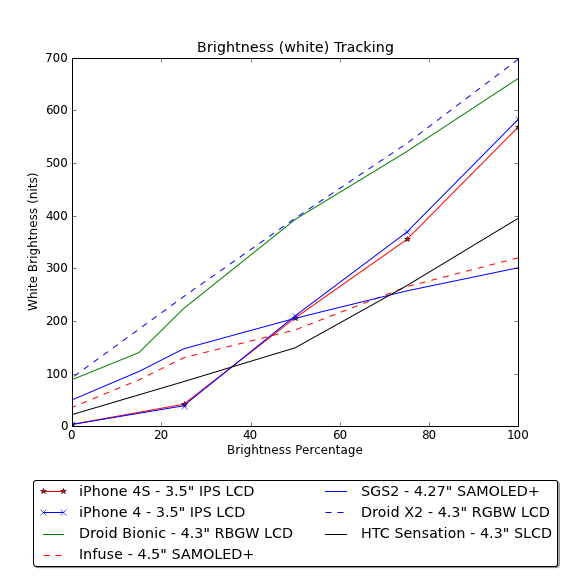
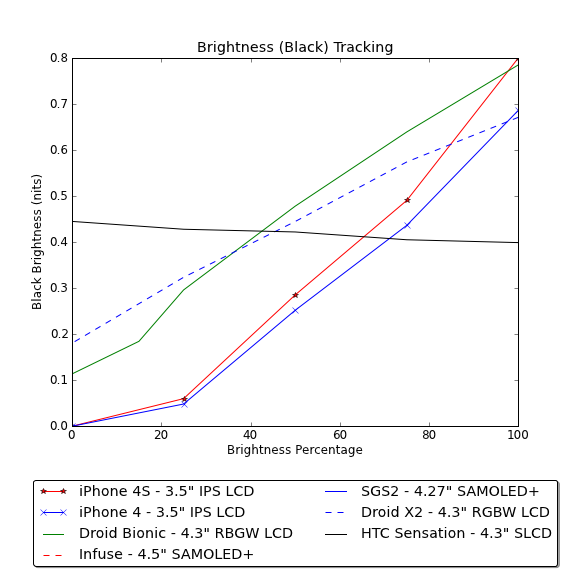
The 4S and 4 displays follow roughly the same curve, however there is a definite shift in contrast resulting from higher black levels on the 4S display. I’ve seen a few anecdotal accounts of the 4S display being less contrasty, and again this is the kind of shift that unfortunately happens over time with displays. I’ve updated our iPhone 4 result on the graph with the latest of a few I’ve been through.
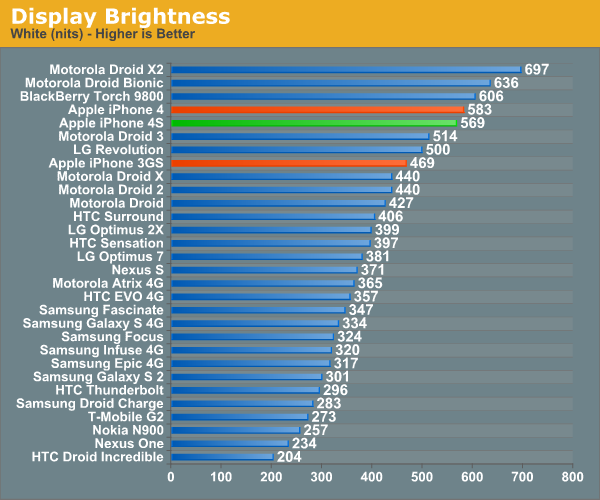
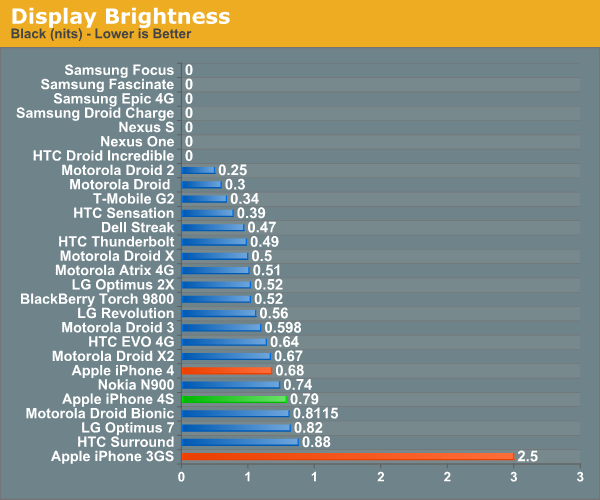
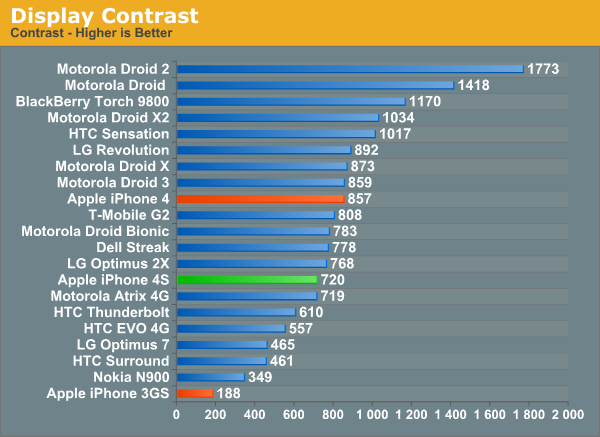
Unfortunately the 4S falls short of the quoted 800:1 contrast ratio, whereas the 4 previously well exceeded it (the earliest 4 we saw had a contrast value of 951). Rumor has it that Apple has approved more panel vendors to make the retina display, I have no doubt that we’re seeing these changes in performance as a result of multiple sourcing.










199 Comments
View All Comments
metafor - Tuesday, November 1, 2011 - link
Fair enough. But that really doesn't take away from the fact that the A5 is a relatively large chip and from the UV-scans of it, looks to use quite a bit of that die area for the GPU.I don't know if a similar scan has been done of Exynos but one can't safely say both chips are far bigger than SoC's traditionally used in this space.
Though that trend appears to be moving forward with MSM8960 and Tegra 3.....
PeteH - Tuesday, November 1, 2011 - link
That leads to an interesting question: will Apple always have the largest SoCs, and thus (most likely) the highest performance in the mobile space?The reason I could see this happening is that Apple doesn't have to sell their SoC's at a profit, so they're paying closer to cost for the chips (excluding the fab mark up). Other manufacturers (like NVIDIA) need to make a profit on their chips.
name99 - Thursday, November 3, 2011 - link
"I'm not entirely sure why they had to use such a powerful GPU, though. "And you know EXACTLY how Apple use the GPU do you?
Does Siri run some of its workload on the GPU? Does the faster camera stuff (eg fast HDR) run on the GPU? Does Apple already have OpenCL running (for internal use) on iOS?
doobydoo - Friday, December 2, 2011 - link
He must be an Android fan.Androids new marketing campaign will offer a revolutionary 'new' feature - the ability to have a slower GPU than other phones!!!
Magical.
InternetGeek - Monday, October 31, 2011 - link
They might give AMD and nVidia a run for their money if they ever tried creating desktop products...sprockkets - Monday, October 31, 2011 - link
Kyro 2 was a good chip, but obviously went to focus on the desktop market.tipoo - Tuesday, November 1, 2011 - link
Maybe, but there's a reason such crossovers usually take so long. Look at Intel trying to get into this space, I don't doubt they will be good at it but it takes years of development. Imagination specializes in low power, it would take lots of development effort to get into the high power desktop game._tangent - Tuesday, November 1, 2011 - link
I think this might be intentionally ironic given they got out of that game a long time ago :POn point though, anyone would given AMD and nVidia a run for their money with the right up front cash and expertise. I imagine the barrier to entry into that market is truly colossal though. Point is, the SGX543 MP2 is no evidence one way or the other.
lurker22 - Monday, October 31, 2011 - link
Before buying many people who got a 4s on AT&T told me how much better it was than their prior AT&T iphones.Anand, thanks for confirming and explaining the reasons.
LordSojar - Monday, October 31, 2011 - link
Can't we have reviews as detailed as this for the really big name Android phones? They are always far less detailed and lack a lot of the testing put into this.... thing....Apple makes a few adjustments, tweaks a few things, adds in the same processor that's in the iPad 2, and we have a highly detailed, scientific review that covers every single aspect, even if said aspects are the same. Samsung releases a new phone that has overall better features, faster CPU, faster NAND, a different and arguably better (or at least equal) screen, and mums the word?
The bias is getting a bit out of hand at this point... We get that you're big time Apple fans, but cmon... At least do a major review of this caliber for the Droid RAZR and the Samsung Galaxy Nexus and the Galaxy S2 Skyrocket (LTE on AT&T!). Even if you combine them into one review, just make it THIS detailed for once instead of giving Apple the huge, super detailed ultra review!